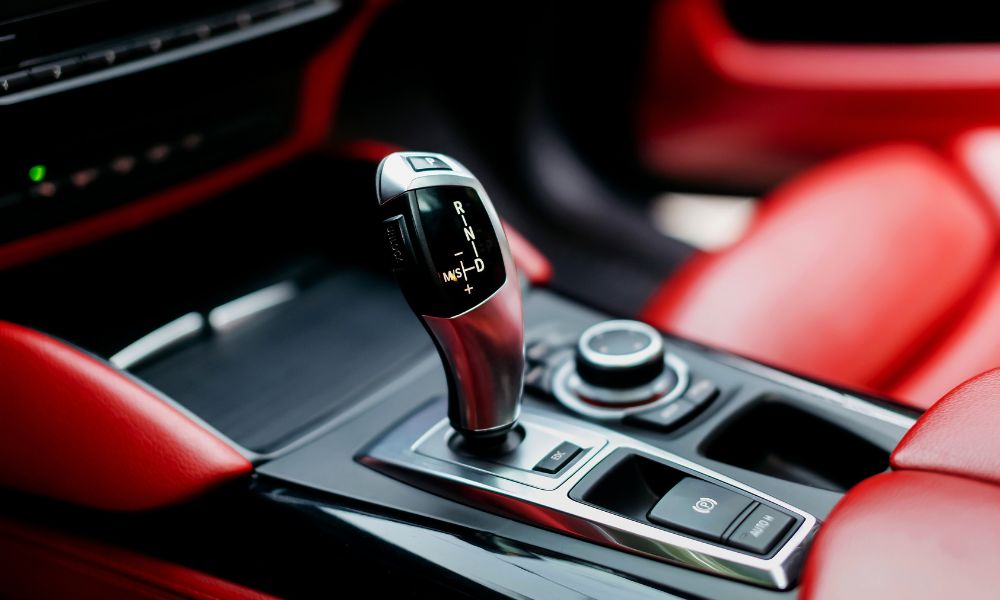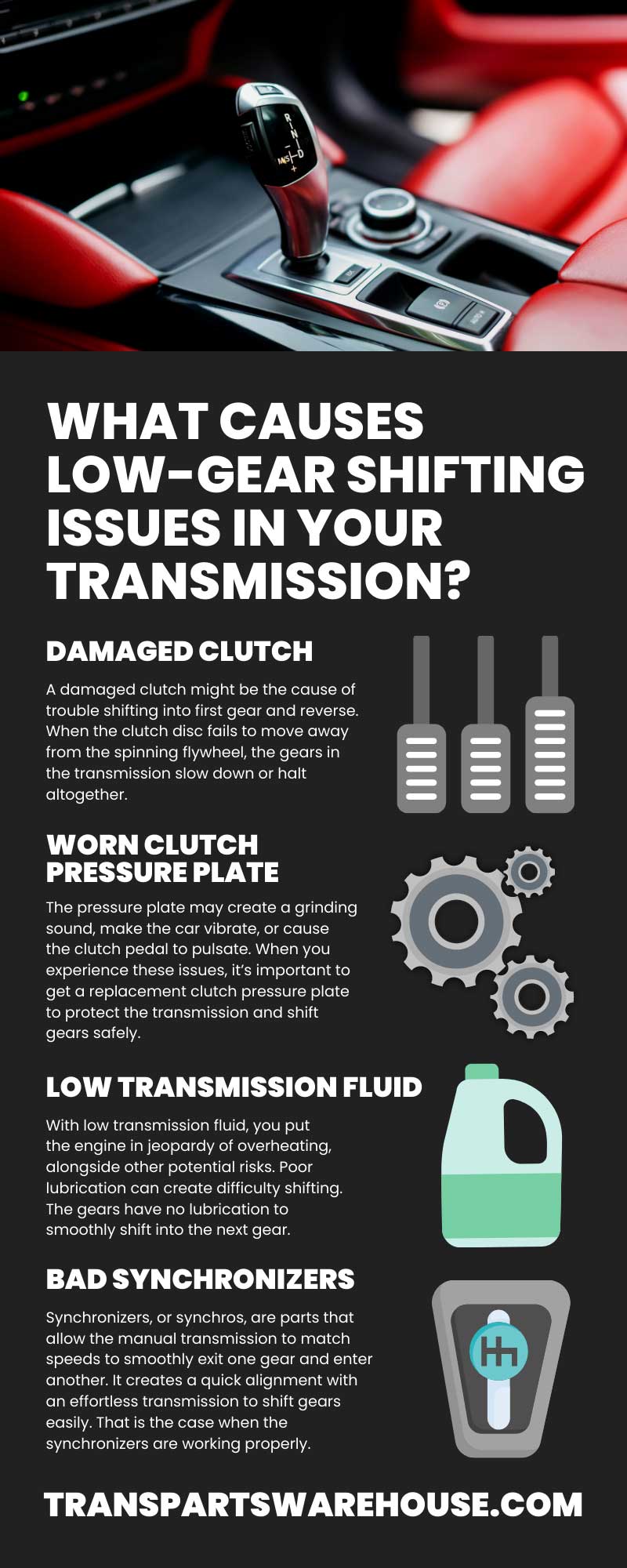
Transmission troubles can happen out of the blue or due to a multitude of reasons. If you’re having issues shifting low gears, continue reading about some of the potential causes of both automatic and manual transmissions.
Causes of Poor Shifting in Automatic Transmissions
Automatic transmissions conduct the shifting work on their own. You don’t have to constantly think about the next gear to change as you increase or decrease speeds. When complications arise while shifting in low gears, the following list is some of the most common issues your vehicle may encounter.
Damage to the Torque Converter
When shifting into low gears, there’s a chance the torque converter is failing. The design of automatic transmissions allows the car to seamlessly shift. The torque converter uses fluid to create power that’s distributed to both the engine and transmission while keeping the system cool. Some people might think of the torque converter as the automatic transmission’s version of a clutch that manual cars use.
When the torque converter experiences any damage to the metal or contaminated fluid, issues begin to arise when shifting. You might feel the vehicle jerk forward or slip into another gear. It can also increase the stall time of the engine.
Leaving this part untreated can cause the vehicle to overheat, damage the transmission, and ruin the vehicle’s transmission fluid. Find the automatic transmission parts for sale that you need to repair the torque converter promptly to keep the transmission running safely.
Faulty Sensors
You may experience challenges shifting gears when the sensors cannot accurately detect the vehicle’s changing speeds or gear shifting. The first common sensor that can malfunction is the vehicle speed sensor, or VSS. A faulty VSS causes the transmission to stop shifting or creates harsh shifting into all gears.
The transmission range sensor measures the position of the gears. It’s an essential tool part that regulates which gear the vehicle must shift into. When the transmission range sensor fails, it’s challenging to activate the correct gear for the speed of the vehicle.
The Powertrain Control Module, or PCM, controls both the engine and the transmission. Its primary function is to time shifting and engage gears. If the sensors malfunction, they can’t send the proper information to the PCM to function correctly.
Failing Transmission Control Module (TCM)
Automatic transmissions heavily rely on the transmission control module or TCM to shift smoothly. The various sensors send signals to the TCM to communicate when to shift gears as the speeds change.
While faulty sensors could be a problem, you may experience trouble shifting low gears when the TCM fails. The vehicle may first flash the check engine light, but there are more serious indicators that can show up instead.
Many cars experience a jerking motion when shifting gears, but there’s something more prominent that occurs with a bad TCM: the car gets stuck in gear. This most commonly occurs when the vehicle is in neutral or first gear. It’s a potentially harmful problem that a mechanic must inspect.
Contaminated Transmission Fluid
Transmission fluid is one of the most important parts that allows vehicles to run properly without overheating or damaging their moving parts. You might be familiar with simply adding more transmission fluid when it’s low, but even when the fluid is full, it can become contaminated.
Contaminated transmission fluid may cause the vehicle to die when shifting or going into reverse. The dirt and debris circulate throughout and infiltrate the systems. It causes challenges in shifting gears when the particles are in the way.
Replacing contaminated transmission fluid can help fix the low-gear shifting issues in your transmission while prolonging the life span of the vehicle.
Causes of Poor Shifting in Manual Transmissions
You might think manual transmissions experience more wear and difficulty shifting gears because of the direct effort that’s conducted. The truth is that there are just as many issues with automatic transmissions as there are manual complications.
Damaged Clutch
A damaged clutch might be the cause of trouble shifting into first gear and reverse. When the clutch disc fails to move away from the spinning flywheel, the gears in the transmission slow down or halt altogether.
Manual cars cannot shift properly without a good-condition clutch. Don’t continue driving on one that’s damaged. Since the clutch such an essential part, you should repair the issue immediately before driving again.
Worn Clutch Pressure Plate
Over time, the pressure plate of a manual car wears down because of excessive use, just like the clutch. It’s natural for these types of vehicles, but a worn pressure plate can cause extensive challenges when shifting gears.
The pressure plate may create a grinding sound, make the car vibrate, or cause the clutch pedal to pulsate. When you experience these issues, it’s important to get a replacement clutch pressure plate to protect the transmission and shift gears safely.
Low Transmission Fluid
As mentioned above, the transmission fluid is a necessary aspect for both automatic and manual cars. This is a complication that can occur within both types of transmissions, but it’s more of an issue for manual vehicles.
With low transmission fluid, you put the engine in jeopardy of overheating, alongside other potential risks. Poor lubrication can create difficulty shifting. The gears have no lubrication to smoothly shift into the next gear.
Take the vehicle to a mechanic to have the transmission fluid inspected. They can check for a potential leak or contaminated fluid and change it if needed.
Bad Synchronizers
Synchronizers, or synchros, are parts that allow the manual transmission to match speeds to smoothly exit one gear and enter another. It creates a quick alignment with an effortless transmission to shift gears easily. That is the case when the synchronizers are working properly.
When a synchronizer goes bad, you’ll notice a sound produced when downshifting, but that’s not the only indicator. The transmission might suddenly jump into neutral when shifting gears. It’s not just an inconvenient issue but also a dangerous situation when driving on the road.
The moment you notice your vehicle is having trouble shifting gears, it’s time to take your car in for a trip to the mechanic. If you know the issue and have the skill to repair it on your own, simply find the parts you need at Transparts Warehouse. Our high-quality car replacement parts are just what you’re looking for to fix up your beloved vehicle.


